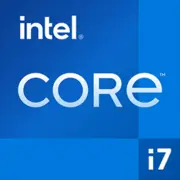Intel Core i7-3910K

Intel Core i7-3910K: Architectural Relic or Budget Solution?
April 2025
Introduction
The Intel Core i7-3910K processor, released in 2012 as part of the Sandy Bridge-E lineup, remains a topic of interest among enthusiasts and users building PCs in the secondary market. Despite its age, its 6 cores and 12 threads can still handle a variety of tasks. In this article, we will explore whether this CPU is still relevant in 2025 and who it might be suitable for.
Key Specifications
Architecture and Process Technology
The i7-3910K is built on the Sandy Bridge-E microarchitecture with a 32nm process technology. This was the first generation from Intel to offer 6 cores for the desktop segment. Key features include:
- 6 cores / 12 threads thanks to Hyper-Threading.
- Base frequency of 3.4 GHz with Turbo Boost up to 3.8 GHz.
- 12MB L3 cache — a significant amount for the era of 2012.
- TDP of 130W — high power consumption even by the standards of its time.
Features:
- Unlocked multiplier (the "K" suffix) for overclocking.
- Support for PCIe 3.0 (up to 40 lanes), which is relevant for multi-GPU configurations.
- Compatibility with X79 chipset motherboards aimed at enthusiasts.
Compatible Motherboards
Socket and Chipsets
The processor uses the LGA 2011 socket, which is now only found on the secondary market. Suitable chipsets include:
- Intel X79 — the main option that supports SLI/CrossFire, overclocking, and up to 64GB of DDR3.
- C600 server boards — rare but allow for the use of ECC memory.
Choosing Recommendations:
- Look for boards with USB 3.0 and SATA III (e.g., ASUS Rampage IV Extreme, Gigabyte GA-X79-UD3).
- Check the condition of the VRM modules — old boards often overheat when overclocked.
- New boards are no longer available; used ones range from $80 to $150 depending on condition.
Supported Memory
The i7-3910K works only with DDR3 (officially supports up to 1600 MHz). In practice, many boards allow memory overclocking to 1866–2133 MHz.
- Maximum capacity: 64GB (8 slots × 8GB).
- Tip: Use quad-channel kits (e.g., 4×8GB) for maximum bandwidth.
Important! DDR4 and DDR5 are not supported — this is a key limitation for upgrading.
Power Supply Recommendations
With a TDP of 130W and the need for stable voltage:
- Minimum: 500W (for systems with a graphics card like the NVIDIA GTX 1660).
- Optimal: 650W (with headroom for overclocking and a powerful GPU).
- Critical: Choose a PSU with an 80+ Bronze certification or higher (e.g., Corsair CX650M, EVGA 600 BQ).
Practical Example:
A system with an i7-3910K and RTX 3060 consumes about ~400W under load. A 600W PSU will ensure stability even under peak loads.
Pros and Cons
Advantages:
1. Multithreaded performance: 12 threads handle rendering and virtualization well.
2. Overclocking potential: With good cooling, frequencies of 4.2–4.5 GHz can be achieved.
3. Availability: On the secondary market, the CPU costs $50–80 (for comparison, a new Ryzen 5 5500 is $120).
Disadvantages:
1. Outdated process technology: 32nm vs. 7nm in modern AMD Ryzen.
2. High power consumption: 130W vs. 65W in the i5-12400.
3. No NVMe or USB 3.1 support: Additional adapters are required.
Use Cases
Gaming
In 2025, the i7-3910K is a weak link for AAA games. Examples (settings at 1080p, medium):
- Cyberpunk 2077: 45–55 FPS (with RTX 3060, possible drops due to CPU bottleneck).
- CS2: 120–150 FPS.
Conclusion: Suitable for esports games, but not for 4K or VR.
Work Tasks
- Video Editing (Premiere Pro): 1080p rendering is acceptable, while 4K is slow.
- 3D Modeling (Blender): Use GPU rendering, as the CPU lags behind modern counterparts.
Multimedia
Ideal for HTPC:
- 4K streaming (with hardware decoding through the GPU).
- Plex server: 6 cores are enough for transcoding 2–3 streams.
Comparison with Competitors
AMD FX-8350 (2012)
- 8 cores but without Hyper-Threading.
- In Cinebench R23 tests: i7-3910K scores 4200 points, FX-8350 scores 2800.
- Conclusion: Intel wins in multithreaded performance.
Intel Xeon E5-1650 v2 (2013)
- Comparable to i7-4930K (6/12, 3.5 GHz).
- Support for ECC memory, but higher price ($100–130 used).
Modern Budget CPUs
- Ryzen 5 5500 (6/12, 7nm): 40% faster in games, TDP of 65W, priced at $120 (new).
- Intel Core i3-13100 (4/8, 10nm): Better for single-threaded tasks but lags in multithreading.
Assembly Tips
1. Cooling: A cooler with a TDP dissipation of 150W or more (e.g., Noctua NH-D14 or similar).
2. Storage: SATA SSD (e.g., Samsung 870 EVO) + PCIe-NVMe adapter for faster boot times.
3. Graphics Card: No higher than RTX 3060 / RX 6600 to avoid bottlenecks.
4. Diagnostics: Check capacitors on the motherboard — old boards tend to bulge.
Final Conclusion: Who is the i7-3910K Best For?
This processor is worth considering for:
- Budget Workstations: For tasks like video editing or running virtual machines on a limited budget ($200–300 for the entire build).
- Upgrading Old Systems: If you already have a motherboard with X79 and DDR3.
- Enthusiast Overclockers: For experimenting with the overclocking of “relic” CPUs.
Why Not to Buy: If you plan to game in 4K or work with AI tools, invest in modern platforms with DDR5 and PCIe 5.0.
In 2025, the i7-3910K is a niche solution, but in its own right, it remains an example of hardware that has outlived its time.
Basic
CPU Specifications
Memory Specifications
GPU Specifications
Share in social media
Or Link To Us
<a href="https://cputronic.com/en/cpu/intel-core-i7-3910k" target="_blank">Intel Core i7-3910K</a>